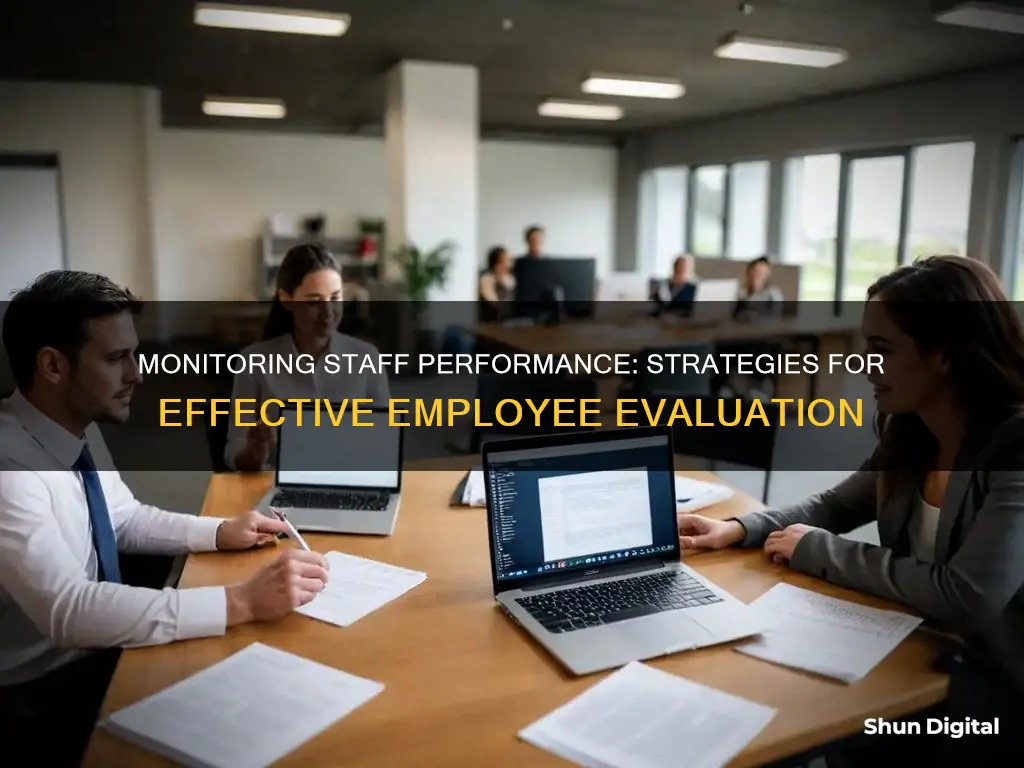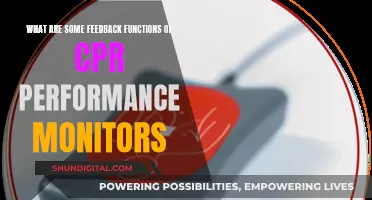
Monitoring staff performance is an important aspect of management. It involves using specific methods to evaluate whether employees are completing their tasks effectively and to a high standard. This process is essential to ensure that employees are aligned with the organisation's goals and objectives. It also helps to identify areas where employees may need additional support or training, boosting overall morale and improving business outcomes. Common measurements of staff performance include the quantity, quality, and efficiency of work. Monitoring staff performance can also help to identify performance issues that could be leading to wider organisational problems.
What You'll Learn

Tracking employee efficiency
Regular Check-Ins and One-on-One Meetings:
Team leaders and managers should schedule regular meetings with employees to discuss progress, address concerns, and provide guidance. These meetings foster transparency, maintain open communication, and help ensure employees and managers are aligned before annual reviews.
Utilise Performance Management Software:
Performance management software streamlines the process of monitoring employee efficiency. These tools help organisations set goals, track progress, and centralise employee performance data. By automating tasks like performance reviews and feedback documentation, managers can save time and make more informed decisions.
Implement Self-Monitoring Tools:
Self-monitoring tools such as checklists, activity logs, and schedules can help employees track their tasks, deadlines, and improve time management skills. These tools also increase employee engagement and initiative, allowing them to monitor their progress and identify areas for improvement.
Observe Employees in Action:
Direct observation is an effective way to gain insight into employee performance, especially when done regularly and without prior notice. Managers can make rounds throughout the day to gauge attitudes, spot potential issues, and provide guidance or assistance as needed.
Review Work in Progress:
Regularly reviewing work in progress is essential for monitoring employee efficiency. For employees producing tangible end products, spot-checking their work provides insight into their performance. For those managing databases or handling customer interactions, reviewing records or observing customer service interactions can provide valuable information.
Gather Feedback and Intelligence:
Asking employees for feedback about their performance and gathering intelligence from colleagues, customers, and other stakeholders can provide valuable insights. This can be done through confidential peer reviews, 360-degree feedback, self-reported surveys, or informal conversations.
It is important to note that while tracking employee efficiency is essential, organisations must also focus on building trust, maintaining transparency, and respecting employee privacy. By combining these methods with a supportive and open work culture, organisations can effectively monitor and improve employee efficiency.
Understanding Monitor Ratio: A Quick Guide to Aspect Ratios
You may want to see also

Performance management software
- Goal setting and tracking: This feature ensures clear communication of expectations and progress, helping employees and managers stay aligned and focused on shared targets.
- 360-degree feedback: Comprehensive feedback is gathered from peers, subordinates, and supervisors, providing a holistic view of an employee's performance and fostering a fair evaluation process.
- Real-time feedback: Enables immediate recognition and constructive criticism, allowing employees to adjust their performance and managers to address issues promptly.
- Performance review automation: Streamlines the scheduling and execution of performance reviews, ensuring consistency and timeliness, and reducing the risk of missing reviews.
- Customisable review templates: Offers flexibility to create tailored review forms that align with the specific needs and criteria of the organisation.
- Analytics and reporting: Provides insights into performance trends and areas for improvement, enabling managers to make data-driven decisions about employee development.
- Integration capabilities: Ensures seamless compatibility with other HR systems and productivity tools, maintaining a smooth flow of data across platforms.
- Security and privacy: Safeguards sensitive employee data, maintaining trust and compliance, and ensuring secure management of personal and performance-related information.
- Mobile accessibility: Allows employees and managers to access the platform on the go, facilitating continuous communication and feedback.
Some popular performance management software solutions include:
- Deel: Best for continuous performance feedback via 1:1 meetings.
- Mitratech Trakstar: Best for connecting all stages of the employee lifecycle, with an easy-to-use interface.
- Performance Pro: Best for performance evaluations of individual competencies, offering detailed performance appraisals and 360-degree feedback collection tools.
- ClearCompany: Best for simplifying and automating HR workflows, with flat-rate pricing.
- GoCo: Best for automating performance review cycles and feedback reminders, integrating with 30+ popular software systems.
- ThriveSparrow: Best for AI-powered performance insights, offering dynamic heatmaps for visualising performance trends.
- PerformYard: Best for customised performance review processes, providing flexible features for HR and a simple employee experience.
- Primalogik: Best for collecting and analysing 360-degree feedback, with real-time feedback tracking and advanced analytics.
- Leapsome: Best for employee development-oriented performance management, offering customisable 360-reviews and employee engagement surveys.
- Peoplebox: Best for linking OKRs and performance reviews, making review meetings efficient with centralised goal-setting and tracking.
Ankle Monitor Discovery: What to Do and What Not to Do
You may want to see also

Regular check-ins and one-on-one meetings
Frequency and Format
It is important to schedule regular check-ins and one-on-one meetings with employees. These meetings can be brief, even as short as ten minutes, and should be informal and open. This frequency helps to maintain a transparent feedback loop and ensures that both parties are on the same page, avoiding surprises during year-end reviews.
Topics to Discuss
During these meetings, it is beneficial to discuss progress, address concerns, and provide guidance. Managers can inquire about the concrete actions taken by the employee since the last meeting and whether expectations were met. It is also an opportunity to ask about any challenges or areas where additional support or training is needed. Finishing the meeting by opening the floor for feedback, suggestions, or goal-sharing further empowers employees and encourages a sense of ownership and autonomy.
Benefits of Regular Check-Ins
Regular check-ins allow managers to gain valuable insights into employees' work and quickly identify areas where improvements can be made. They also help to build trust and improve employee engagement, productivity, and well-being. Additionally, these meetings can serve as a platform for constructive feedback, which is essential for employee development and motivation.
Remote Work Considerations
For remote or hybrid teams, managers can utilise video calls, screen sharing, and remote-access programs to observe employees' work and provide real-time corrections or guidance. Paying attention to conference calls and messaging channels can also provide insights into employee performance and sentiment.
Combining with Other Methods
While regular check-ins are crucial, they should be combined with other performance monitoring methods. This can include the use of performance management software, self-monitoring tools, peer reviews, and 360-degree feedback to gain a holistic understanding of employee performance and create a culture of transparency and continuous improvement.
In summary, regular check-ins and one-on-one meetings are a vital aspect of staff performance monitoring. They facilitate open communication, provide opportunities for feedback and guidance, and help to align employees with the organisation's goals and objectives.
Asus Monitor: Is Renewed a Smart Choice?
You may want to see also

Monitoring staff activity
There are several methods to monitor staff activity, including:
- Regular check-ins and one-on-one meetings: Team leaders should regularly meet with employees to discuss progress, provide feedback, and address concerns in a casual, transparent setting. This helps to build a positive working relationship and ensures everyone is on the same page.
- Performance management software: Using software to streamline the performance monitoring process makes it more efficient and effective. These tools help set goals, track progress, and monitor employee performance, freeing up time for managers and HR professionals.
- Employee monitoring software: This type of software provides hard data on employee performance, showing where roadblocks are hindering progress. It is important to choose a platform that maintains employee privacy while providing the needed insights.
- Peer reviews and 360-degree feedback: Confidential evaluations from colleagues, subordinates, and managers provide a holistic view of an employee's strengths and areas for improvement. This method has been shown to increase productivity and profitability.
- Self-reported surveys: Asking employees how they think they are doing can significantly improve engagement. While these surveys need to be carefully scripted to elicit honest responses, they provide employees with a platform to speak their minds about their performance and that of their colleagues.
- Direct observation: For in-person teams, observing employees in action can provide valuable insights. Regularly making rounds and shadowing employees can help spot problems and inefficient habits. For remote teams, video calls, screen sharing, and remote-access programs can be used to mimic in-person observations.
It is important to note that monitoring staff activity should be done with care to avoid breaking employee trust and ensure compliance with data protection regulations.
LCD Monitor Vertical Lines: What's the Issue?
You may want to see also

Measuring effectiveness of enrichment programs
Measuring the Effectiveness of Enrichment Programs
Monitoring staff performance is an important aspect of a manager's role. It is inefficient to assign work and expect it to be completed without checking in with employees. Regular check-ins and feedback are necessary to ensure employees are on the right track and to identify areas for improvement.
Tracking Employee Efficiency
Measuring the effectiveness of enrichment programs involves evaluating whether these programs have improved employee efficiency and productivity. This can be done by setting Key Performance Indicators (KPIs) and tracking whether employees are meeting or exceeding benchmarks.
Establishing Training and Development Needs
Enrichment programs such as training and development modules aim to bridge skill gaps and improve employee performance. By continuously monitoring employee performance after the implementation of these programs, organizations can evaluate their success and identify areas for further improvement.
Measuring Employee Engagement
Employee engagement is the emotional commitment an employee has to the organization and its goals. An effective enrichment program fosters employee engagement by ensuring employees feel supported and able to thrive. Organizations can measure employee engagement through surveys, scorecards, and feedback sessions.
Providing Feedback and Recognition
Constructive feedback is an important aspect of monitoring staff performance. Regular feedback helps build healthy relationships between employees and management and allows employees to share their concerns. Recognizing and rewarding employees for their achievements also boosts morale and motivates them to improve.
Improving Organization's Productivity
The main goal of monitoring staff performance is to improve employee productivity, which in turn leads to increased overall productivity for the company. By identifying areas where employees excel or struggle, organizations can make necessary changes to enhance performance and achieve maximum productivity.
Best Practices for Measuring Effectiveness
- Set clear objectives and communicate them to employees
- Offer continuous training and development opportunities
- Foster transparency and trust between management and employees
- Encourage employee engagement through recognition and rewards
- Utilize performance management software to streamline the monitoring process
- Gather feedback from employees through surveys, scorecards, and one-on-one meetings
- Compare performance data before and after the implementation of enrichment programs to evaluate their impact
Nutrisence Sugar Monitor: A Buyer's Guide
You may want to see also
Frequently asked questions
Monitoring staff performance is the act of using specific methods to identify whether employees are completing their tasks effectively and to a high standard. It is an important aspect of staying competitive and ensuring that employees are aligned with the organisation's goals and objectives.
Monitoring staff performance offers several benefits, including:
- Identifying areas where employees need additional support and training
- Improving employee engagement, productivity, motivation, and well-being
- Providing insights into the progress of projects and identifying performance issues
- Helping managers and HR make informed decisions regarding performance appraisals, coaching, and training requirements
- Establishing a transparent and positive working relationship between managers and employees
There are several methods for monitoring staff performance, including:
- Regular check-ins and one-on-one meetings
- Using performance management software
- Implementing self-monitoring tools such as checklists and activity logs
- Observing employees in action and visually monitoring their work
- Analysing work in progress and spot-checking long-term projects
- Gathering feedback from employees, peers, and other stakeholders
When monitoring staff performance, it is important to:
- Establish clear objectives and expectations for employees
- Maintain a balance between trust and verification
- Respect employee privacy and comply with relevant data protection laws
- Foster a positive and open work culture where employees feel comfortable discussing concerns
- Provide constructive feedback and recognise and reward good performance







